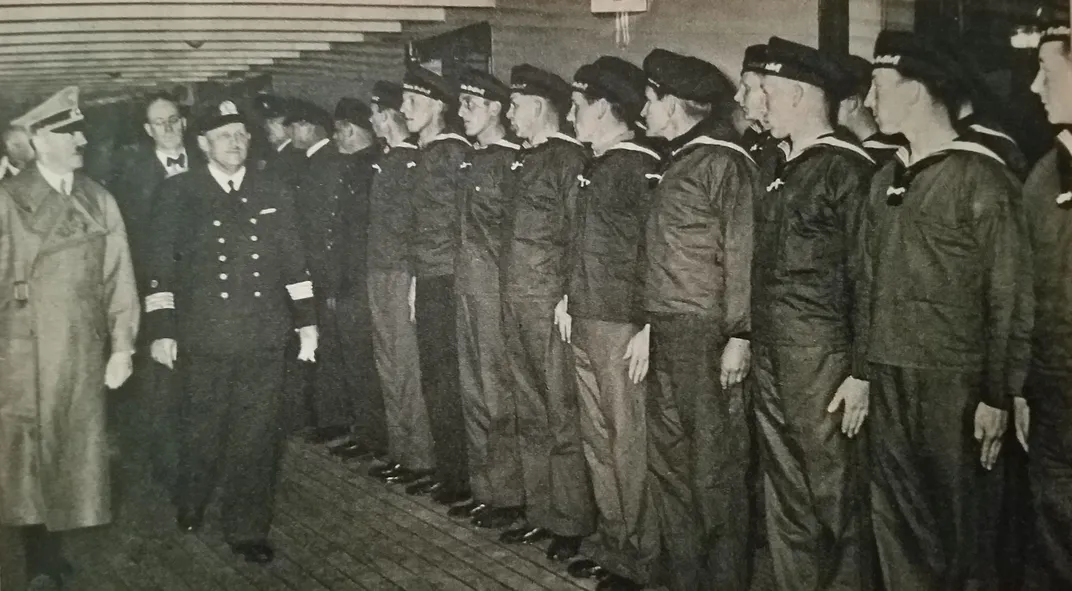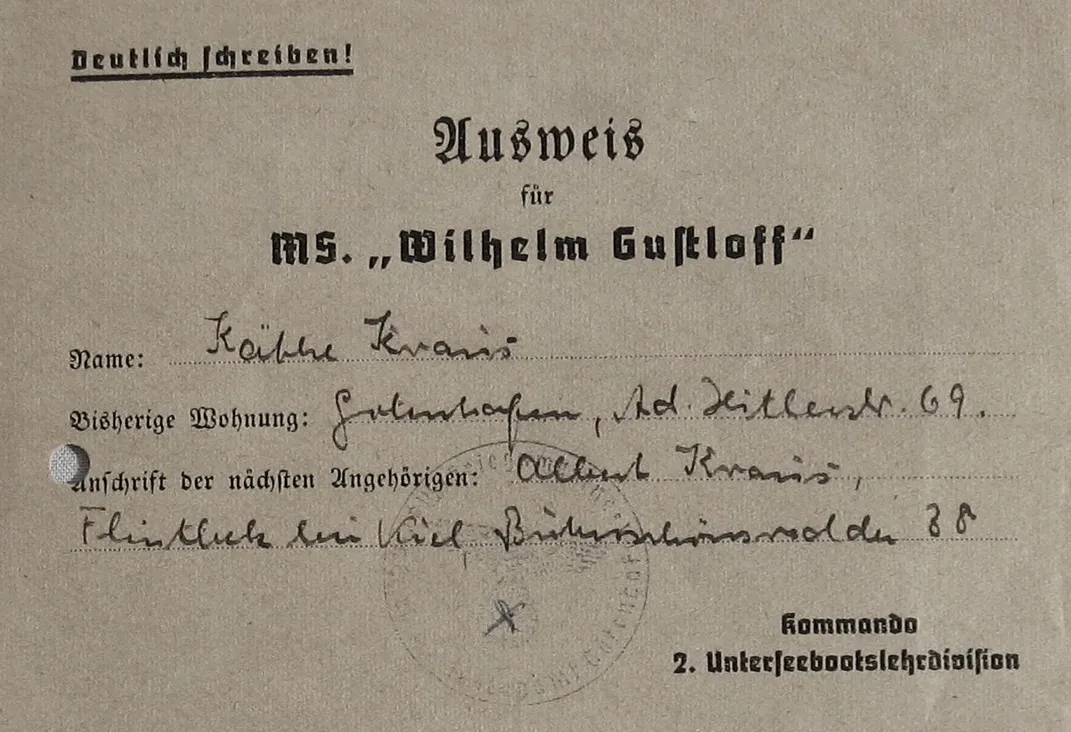The Deadliest Disaster at Sea Killed Thousands, Yet Its Story Is Little-Known. Why?
In the final months of World War II, 75 years ago, German citizens and soldiers fleeing the Soviet army died when the “Wilhelm Gustloff” sank
/https://tf-cmsv2-smithsonianmag-media.s3.amazonaws.com/filer/ea/d3/ead39ecb-3af2-4388-b51d-65b97dcd764e/c45e9c.jpg)
By the time the Soviet Union advanced on Germany’s eastern front in January of 1945, it was clear the advantage in World War II was with the Allies. The fall of the Third Reich was by this point inevitable; Berlin would succumb within months. Among the German populace, stories of rape and murder by vengeful Soviet forces inspired dread; the specter of relentless punishment pushed many living in the Red Army’s path to abandon their homes and make a bid for safety.
The province of East Prussia, soon to be partitioned between the Soviet Union and Poland, bore witness to what the Germans called Operation Hannibal, a massive evacuation effort to ferry civilians, soldiers and equipment back to safety via the Baltic Sea. German civilians seeking an escape from the advancing Soviets converged on the port city of Gotenhafen (now Gdynia, Poland), where the former luxury ocean liner Wilhelm Gustloff was docked. The new arrivals overwhelmed the city, but there was no turning them back. If they could get to the dock and if they could get on board, the Gustloff offered them a voyage away from besieged East Prussia.
“They said to have a ticket to the Gustloff is half of your salvation,” ship passenger Heinz Schön recalled in an episode of the early 2000s Discovery Channel series “Unsolved History.” “It was Noah’s Ark.”
The problem, however, was that the Soviet navy lay in wait for any transports that crossed their path and sank the Gustloff 75 years ago this week in what is likely the greatest maritime disaster in history. The death toll from its sinking numbered in the thousands, some put it as high as 9,000, far eclipsing those of the Titanic and Lusitania combined.
Most of the Gustloff’s estimated 10,000 passengers—which included U-boat trainees and members of the Women’s Naval Auxiliary—would die just hours after they boarded on January 30, 1945. The stories of the survivors and the memory of the many dead were largely lost in the fog of the closing war, amid pervasive devastation and in a climate where the victors would be little inclined to feel sympathy with a populace considered Nazis—or at the very least, Nazis by association.
Before the war, the 25,000-ton Wilhelm Gustloff had been used “to give vacationing Nazis ocean-going luxury,” the Associated Press noted shortly after its 1937 christening, part of the “Strength Through Joy” movement meant to reward loyal workers. The ship was named in honor of a Nazi leader in Switzerland who had been assassinated by a Jewish medical student the year before; Adolf Hitler had told mourners at Gustloff’s funeral that he would be in “the ranks of our nation’s immortal martyrs.”

The realities of war meant that instead of a vacationing vessel the Gustloff was soon used as a barracks; it had not been maintained in seaworthy condition for years before it was hastily repurposed for mass evacuation. Despite having earlier been prohibited from fleeing, German citizens understood by the end of January that no other choice existed. The Soviet advance south of them had cut off land routes; their best chance at escape was on the Baltic Sea.
Initially German officials issued and checked for tickets, but in the chaos and panic, the cold, exhausted, hungry and increasingly desperate pressed on board the ship and crammed into any available space. Without a reliable passenger manifest, the exact number of people onboard during the sinking will never be known, but what is beyond doubt is that when this vessel—built for less than 2,000 people—pushed off at midday on the 30th of January, it was many times over its intended capacity.
Early on, the ship’s senior officers faced a series of undesirable trade-offs. Float through the mine-laden shallower waters, or the submarine-infested deeper waters? Snow, sleet and wind conspired to challenge the crew and sicken the already beleaguered passengers. Captain Paul Vollrath, who served as senior second officer, later wrote in his account in Sea Breezes magazine that adequate escort ships were simply not available “in spite of a submarine warning having been circulated and being imminent in the very area we were to pass through.” After dark, to Vollrath’s dismay, the ship’s navigation lights were turned on—increasing visibility but making the massive ship a beacon for lurking enemy submarines.
Later that evening, as the Gustloff pushed into the sea and westward toward relative safety in the German city of Kiel, Hitler delivered what would be his last radio address and commanded the nation “to gird themselves with a yet greater, harder spirit of resistance,” sparing none: “I expect all women and girls to continue supporting this struggle with utmost fanaticism.” His futile exhortations were carried on the airwaves—and broadcast on the Gustloff itself—12 years to the day of when he formally assumed power on January 30, 1933.

Soon the nearby Soviet submarine S-13, under the command of Alexander Marinesko, who was in a tenuous position with his own chain of command after his mission was delayed by his land-based alcohol consumption habits, spotted the large, illuminated ship. It presented an easy target for a commander who could use a boost to his reputation. “He thought he would be a real hero for doing it,” says Cathryn J. Prince, author of Death in the Baltic: The World War II Sinking of the Wilhelm Gustloff.
Shortly after 9 p.m., the S-13 unleashed three torpedoes, each inscribed with messages conveying the Soviets’ desire for revenge for the suffering inflicted on the Soviet populace by Nazi forces earlier in the war. These explosions impacted crew living quarters, the swimming pool area that housed members of the Women’s Naval Auxiliary, and finally the engine room and lower decks, dealing the ship its fatal blows and trapping many occupants with no means of escape.
The Gustloff was soon the scene of a mad scramble for survival. Even for those who could get off the mortally wounded ship and seek safety in the open water, the sheer number of passengers far exceeded the capacity of the life rafts. Survivor Horst Woit, who was just 10 years old, saw people—many of them children—trampled to death in an effort to get up the stairs and on to an available lifeboat (the ship was tilted toward the port side, so none of the lifeboats on the starboard side were accessible). After cutting the ropes with a knife he had taken from his uncle’s uniform, Woit was one of the lucky few on a boat moving away from the Gustloff. “A lot of the people jumped. And then they all tried to get on to the lifeboat and of course they pull you over and they get hit in the head with a paddle, and they get hit on the hands,” Woit told BBC Witness. “[It was] just gruesome, just awful. Most of them died.”
Mere feet separated the spared and the doomed. “Perhaps the decision not to take any more people and leave them to their fate was the hardest I ever had to make,” Vollrath wrote. “Here was comparative safety inside the boat, on the other side certain death.”
For those who remained on deck, it was becoming apparent that death in the freezing water was imminent. Schön, who ultimately devoted years to studying the shipwreck he had survived, later recounted in a documentary on the National Geographic Channel the agonizing decision of a father hanging off the listing ship—still wearing his swastika arm band—to shoot his wife and children. He ran out of bullets when he put the gun to his own head. “And then he let go and slide after his dead wife and his children across the icy, snow-covered deck, and over the side,” Schön recalled.
As German rescue boats summoned by the Gustloff’s crew approached to pick up survivors, they faced the same dilemma as those in lifeboats: who to pick up, and when to stop. They, too, were at risk from the S-13. Torpedo boat commander Robert Hering, aboard the T-36, had to make the decision to leave many more behind when his boat was at full capacity. He then had to take evasive maneuvers to avoid suffering the same fate as the Gustloff.
Just over an hour after the S-13’s torpedoes hit, the Gustloff sunk into the sea.
By the next morning, the waters surrounding the Gustloff were filled with bodies, many of them those of children whose lifejackets caused them to float upside down. Only one known survivor emerged from the floating graveyard—an infant wrapped tightly in blankets aboard a lifeboat, surrounded by deceased passengers. (The officer who found the infant would adopt and raise the boy). Of the passengers who had boarded the previous day a mere fraction—roughly 1,000—had survived.
Despite the magnitude of the tragedy, in the frenzied closing months of the war it would receive little attention. This may be partially attributed to the sheer pace and staggering death tolls happening across the European theater. Yet neither side—a Nazi Germany near defeat, nor a Soviet Union on its way to brutal victory—had an incentive to widely broadcast the deaths of so many citizens. It would be weeks before word of the Gustloff reached the United States, and then only a few short wire stories appeared citing snippets from Finnish radio broadcasts.
Furthermore, the Gustloff, though its toll is considered the highest, was not the only ship to go down in the Baltic during Operation Hannibal. Weeks later, the General von Steuben was also sunk by Marinesko (the credit he sought was slow in coming—his reputation didn’t recover in his lifetime, but he would be posthumously celebrated for his wartime actions.) In the spring, the sinking of the Goya would add another 7,000 to the Baltic toll; the Cap Arcona was sunk by British forces with 4,500 concentration camp prisoners on board.
In context, the Gustloff was another tragedy in a war full of losses. By then, “there was a stigma about discussing any sort of German suffering during the war after everything the Nazis did to the rest of Europe,” Edward Petruskevich, curator of the online Wilhelm Gustloff Museum, writes in an e-mail. “The Gustloff was just another casualty of war along with the countless other large ships sunk on the German side.”
Even if the details of the Gustloff or other German ships had been more widely or immediately known, considering the reigning public sentiment in the United States and other Allied countries it may not have elicited much sympathy. After years of total war, the fall of the Third Reich meant that German civilians also found themselves on the other side of a Manichean divide.
“I think there was that inability to look at the humanity of people who were the foe,” says Prince.
But whatever category those Wilhelm Gustloff victims fit into—U-boat trainees, Women’s Naval Auxiliary Members, Hitler Youth, reluctant conscripts, German civilians, mothers and children—they were part of a maritime tragedy that has yet to be rivaled in scale. In little over an hour, Vollrath wrote, the Gustloff had “dragged love, hope, and wishes down to the bottom of the sea.”